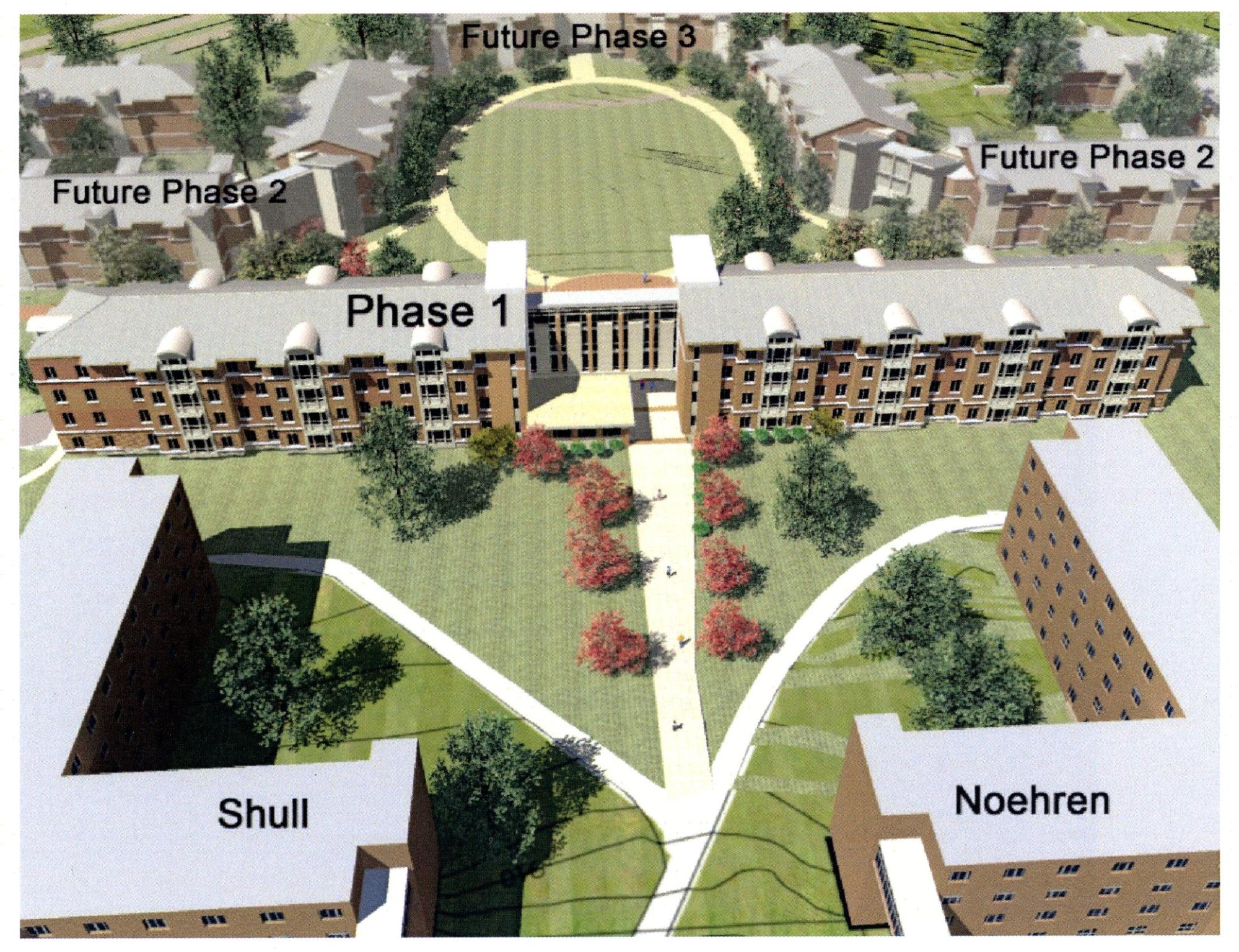Panther Village (2010)
During the 2009-2010 school year, Assistant Vice President and Executive Director of Residence Michael A. Hager promoted the feasibility of constructing additional on-campus housing. Specifically, he believed that UNI students wanted more apartment style residence halls and cited several factors. First, he noted the age of existing apartment-style housing: the College Courts complex was over fifty years old and the Hillside Courts complex was almost forty years old. Second, he noted the loss of over two hundred beds when Shull Hall was converted to single rooms in 2004. Hager believed that demand for additional on-campus housing existed even though the local private housing sector seemed to be showing an excess of housing units.
In May 2010, the Board of Regents approved schematic design plans for a new housing complex to be located south of the Regents Complex. InVison Architecture drew up plans for the complex, which would be developed in three phases. According to an article in the Waterloo Courier, the first phase would consist of about two hundred bedrooms in about sixty apartments. Each apartment unit would feature a common living room and kitchen. The first phase would cost about $19.5 million and might be available for students in the fall of 2012. The second phase would require the demolition of College Courts. This phase would add about 474 beds. The third phase would add about 134 beds. When all three phases were complete, Hillside Courts would no longer be used for student housing. The total cost of all three phases was estimated at about $64 million. Funds for the project would come from residence system revenue bonds and the residence system budget.
Construction got underway in August 2010 and progressed well through the winter. In April 2011, Assistant Vice President Hager announced that the new complex would be named Panther Village. He stated that Phase I would be ready for occupancy by 204 students in the fall of 2012. Most apartments would have four students in single bedrooms with shared living, dining, and kitchen space. In an article in the Waterloo Courier, Vice President Hager stated:
“The name embodies UNI pride and a sense of community for the new apartment complex south of Redeker Center. The residence community project was initiated to diversify housing inventory to meet needs of current and future students who are looking for a different level of independence in their housing while retaining all the academic and social advantages of living on campus.”

Plans for the construction of Phase II were well underway long before Phase I was completed. The Department of Residence notified residents of College Courts, which were situated on the site where Phase II will be built, that units there would be unavailable after the close of the 2011 spring semester. Demolition of College Courts got underway in June 2011. Plans called for Phase II of Panther Village to be ready for 246 students in the fall of 2013. After the rubble was cleared from the College Courts site, the area was graded in August 2011. Construction on Phase II of the Panther Village complex got underway immediately afterward.
The University Art and Architecture Committee selected Lynn Basa to create the artwork for Panther Village. She had also been responsible for the artwork in the renovation of Sabin Hall. According to Vice President Michael Hager, Basa toured the UNI Department of Art facilities when she was on campus for her presentation. She was impressed by the quality of the facilities on campus and thought that she could fabricate much of her work there with the help of UNI students.
Work on Phase I moved steadily during the fall of 2011 and during the very mild winter and spring of 2011-2012. Officials still planned for the building to be ready for occupancy in the fall of 2012. An article in the October 21, 2011, Northern Iowan stated that Phase I would include "a fitness room, elevators, study areas, an atrium, laundry rooms on each floor, a computer lab, and a meeting room." The building would also be air-conditioned. Rooms would include some furniture and appliances. Residence staff believed that Panther Village could compete successfully with private, off-campus housing.
In keeping with the campus emphasis on sustainability, the building was constructed under Leadership in Energy and Environmental Design guidelines, the same guidelines under which Sabin Hall was renovated. It has proven to be a popular living choice for UNI students.
Essay by University Archivist Gerald L. Peterson, July 6, 2010; scanning by Library Assistant David Glime; last updated, April 13, 2012 (GP); photos and captions updated by Graduate Assistant Eliza Mussmann February 8, 2023; content updated by Graduate Intern Marcea Seible, June 2025.


















